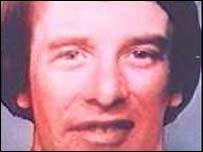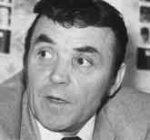The Stevens Inquiries were three official British government inquiries led by Sir John Stevens concerning collusion in Northern Ireland between loyalist paramilitaries and the state security forces. While Stevens declared in 1990 that collusion was "neither wide-spread nor institutionalised", by April 2003 he acknowledged that he had uncovered collusion at a level "way beyond" his 1990 view. Much of Stevens' evidence was obtained from advanced fingerprint techniques to link people to documents. By 2005 the team had identified 2,000 people from their prints with a further 1,015 sets of prints outstanding.
The Force Research Unit (FRU) was a covert military intelligence unit of the British Army's Intelligence Corps. It was established in 1982 during the Troubles to obtain intelligence from terrorist organisations in Northern Ireland by recruiting and running agents and informants. From 1987 to 1991, it was commanded by Gordon Kerr.
Freddie Scappaticci was an Irish IRA member named in the Kenova report, as a British Intelligence mole with the codename ‘Stakeknife’.

Patrick Finucane was an Irish lawyer who specialised in criminal defence work. Finucane came to prominence due to his successful challenge of the British government in several important human rights cases during the 1980s. He was killed by loyalist paramilitaries from the Ulster Defence Association (UDA), acting in collusion with British security services. In 2011, British Prime Minister David Cameron met with Pat Finucane's family and apologised for the collusion.

Denis Martin Donaldson was a volunteer in the Provisional Irish Republican Army (IRA) and a member of Sinn Féin who was killed following his exposure in December 2005 as an informer in the employ of MI5 and the Special Branch of the Police Service of Northern Ireland. It was initially believed that the Provisional IRA were responsible for his killing although the Real IRA claimed responsibility for his murder almost three years later. His friendship with French writer and journalist Sorj Chalandon inspired two novels: My Traitor and Return to Killybegs.
Stormontgate is the name given to the controversy surrounding an alleged Provisional Irish Republican Army spy ring and intelligence-gathering operation based in Stormont, the parliament building of Northern Ireland. The term was coined in October 2002 after the arrest of Sinn Féin's Northern Ireland Assembly group administrator Denis Donaldson, his son-in-law Ciarán Kearney, and former porter William Mackessy for intelligence-gathering on 4 October 2002.

The Shankill Road bombing was carried out by the Provisional Irish Republican Army (IRA) on 23 October 1993 and is one of the most well-known incidents of the Troubles in Northern Ireland. The IRA aimed to assassinate the leadership of the loyalist Ulster Defence Association (UDA), supposedly attending a meeting above Frizzell's fish shop on the Shankill Road, Belfast. Two IRA members disguised as deliverymen entered the shop carrying a bomb, which detonated prematurely. Ten people were killed: one of the IRA bombers, a UDA member and eight Protestant civilians, two of whom were children. More than fifty people were wounded. The targeted office was empty at the time of the bombing, but the IRA had allegedly realised that the tightly packed area below would inevitably cause "collateral damage" of civilian casualties and continued regardless. However, the IRA have denied this saying that they intended to evacuate the civilians before the explosion. It is alleged, and unearthed MI5 documents appear to prove, that British intelligence failed to act on a tip off about the bombing.
Martin Ingram is the pseudonym of ex-British Army soldier Ian Hurst, who served in the Intelligence Corps and Force Research Unit (FRU). He has made a number of allegations about the conduct of the British Army, its operations in Northern Ireland via the FRU, and against figures in the Provisional Irish Republican Army (IRA) and Sinn Féin.
The Internal Security Unit (ISU) was the counter-intelligence and interrogation unit of the Provisional Irish Republican Army (IRA). This unit was often referred to as the Nutting Squad.

Operation Banner was the operational name for the British Armed Forces' operation in Northern Ireland from 1969 to 2007, as part of the Troubles. It was the longest continuous deployment in British military history. The British Army was initially deployed, at the request of the unionist government of Northern Ireland, in response to the August 1969 riots. Its role was to support the Royal Ulster Constabulary (RUC) and to assert the authority of the British government in Northern Ireland. This involved counter-insurgency and supporting the police in carrying out internal security duties such as guarding key points, mounting checkpoints and patrols, carrying out raids and searches, riot control and bomb disposal. More than 300,000 soldiers served in Operation Banner. At the peak of the operation in the 1970s, about 21,000 British troops were deployed, most of them from Great Britain. As part of the operation, a new locally-recruited regiment was also formed: the Ulster Defence Regiment (UDR).
Peter Keeley, who uses the pseudonym Kevin Fulton, is a British agent from Newry, Northern Ireland, who allegedly spied on the Provisional Irish Republican Army (IRA) for MI5. He is believed to be in London, where he is suing the Crown, claiming his military handlers cut off their connections and financial aid to him. In 2004, he reportedly sued the Andersonstown News, an Irish republican news outlet in Belfast, for revealing his identity as well as publishing his photograph. The result of that suit has not been made public.
Martin McGartland is a former British informer who infiltrated the Provisional Irish Republican Army (IRA) in 1989 to pass information to RUC Special Branch.
Joseph "Joe" Fenton was an estate agent from Belfast, Northern Ireland, killed by the Provisional Irish Republican Army (IRA) for acting as an informer for RUC Special Branch.

Brian Nelson was an Ulster loyalist paramilitary member during The Troubles in Northern Ireland. He was an intelligence chief of the Ulster Defence Association (UDA), and also a clandestine agent for the British Army's Force Research Unit during the conflict.

Tommy "Tucker" Lyttle, was a high-ranking Ulster loyalist during the period of religious-political conflict in Northern Ireland known as "the Troubles". A member of the Ulster Defence Association (UDA) – the largest loyalist paramilitary organisation in Northern Ireland – he first held the rank of lieutenant colonel and later was made a brigadier. He served as the UDA's spokesman as well as the leader of the organisation's West Belfast Brigade from 1975 until his arrest and imprisonment in 1990. According to journalists Henry McDonald and Brian Rowan, and the Pat Finucane Centre, he became a Royal Ulster Constabulary (RUC) Special Branch informer.
Thomas Oliver was a 43-year-old Irish farmer who was tortured and murdered by the Provisional Irish Republican Army in July 1991, reportedly for passing information to the Garda Síochána. However, in the wake of the Stakeknife case it began to be suspected that Freddie Scappaticci – who ran the IRA's Internal Security Unit, which was responsible for torturing and killing Thomas Oliver – killed Oliver to conceal his identity as a double agent.
Catherine and Gerard Mahon were a husband and wife who lived in Twinbrook, Belfast. Gerard, aged twenty-eight, was a mechanic; Catherine, was twenty-seven. They were killed by the Provisional Irish Republican Army (IRA) on 8 September 1985, the IRA alleging they were informers. However at least two of those responsible for their deaths were later uncovered as British agents within the IRA's Internal Security Unit, leaving the actual status of the Mahons as informers open to doubt.
John Joe McGee was an IRA volunteer who was formerly in the British Special Boat Service.
Margaret Perry was a 26-year-old woman from Portadown, County Armagh, Northern Ireland who was abducted on 21 June 1991. After a tip from the IRA, her body was found buried across the border in a field in Mullaghmore, County Sligo, Ireland, on 30 June 1992. She had been beaten to death. Her murder has never been solved.
Operation Kenova is an ongoing criminal investigation into whether the Royal Ulster Constabulary in Northern Ireland failed to investigate as many as 18 murders in order to protect a high level double agent codenamed Stakeknife who worked for the Force Research Unit, while at the same time he was deeply embedded and trusted within the Provisional Irish Republican Army (IRA). The 2017, initial investigation was headed up by Jon Boutcher the former Chief Constable of Bedfordshire Police until his appointment as Chief Constable of the Police Service of Northern Ireland in 2023. It is now led by Iain Livingstone, former Chief Constable of Police Scotland.





